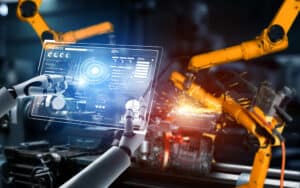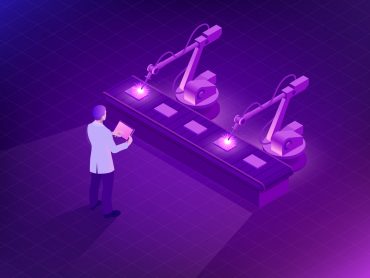
Smart manufacturing helps automakers achieve greater efficiency and accelerate innovation by blending digital technologies with the physical realm, making it possible to accomplish things we’ve never seen before.
Despite supply chain disruptions and complexity caused by a changing automotive and manufacturing landscape, a beacon of opportunity has emerged – the fusion of digital and physical worlds. Auto manufacturers are abandoning traditional manufacturing for a more agile, innovative workflow, and this remarkable journey is reshaping automotive manufacturing for good. Let’s explore the advancements in automotive smart manufacturing that make integrating digital technologies with the physical realm possible and what impact they’ll have on the industry.
The rise of smart automotive manufacturing
The emergence of cutting-edge tech has allowed manufacturers to integrate technology seamlessly into human-centered activities. Some of these technologies include:
- Internet of Things (IoT)
- AI
- Robotics
- Additive manufacturing
In theory, leveraging these technologies allows automotive manufacturers to achieve better efficiency and productivity, as well as improve quality, without taxing existing human teams. Humans are great workers but prone to errors due to fatigue, distraction, or overwhelm. By putting machines into the mix — ones that never tire or miss a detail — humans are freer to do what humans do best: innovate and problem-solve.
See also: Digital Twins, IT/OT Convergence Drive the Industrial Internet
Connecting the smart manufacturing dots
Let’s take a closer look at what technologies the automotive industry is embracing.
Cloud-based platforms and connectivity
Cloud computing provides scalable storage, computational power, and seamless connectivity to handle periods of high demand and scale back. Because cloud computing offers on-demand access to scalable computing power, manufacturers can utilize processing-heavy, resource-intensive technology. In fact, everything in this article requires this type of processing; cloud platforms facilitate the integration of digital systems. By connecting ERP systems, manufacturing execution systems (MES), and other software applications to the cloud, manufacturers can achieve seamless data flow and interoperability. This integration optimizes production planning, inventory management, demand forecasting, and supply chain coordination.
Cloud-based platforms play a crucial role in blending physical and digital realms. They offer centralized data storage and accessibility designed to handle big data volumes generated from smart manufacturing. Automakers can analyze data across the entire manufacturing ecosystem to improve processes and mitigate risks. These platforms enable better collaboration, breaking down siloes and encouraging cross-functional involvement.
Digital twin technology
Digital twins allow manufacturers to create virtual replicas of physical assets and processes. This digital simulation allows manufacturers to test scenarios without disrupting actual operations and then apply insights to physical manufacturing components. This enables greater production efficiency and streamlines quality control.
Artificial intelligence algorithms can “play” within these digital twins to learn what works best and discover patterns that lead to inefficiencies. It can also better predict maintenance needs and offer choices for scheduling maintenance requests that cause as little downtime as possible. Although AI operates within a digital environment, it mirrors physical locations that decision-makers can upgrade and optimize.
Virtual and augmented reality
The automotive industry has embraced VR and AR technologies to help the design and production processes evolve. For example, engineers and designers can use VR to visualize and refine vehicle designs, which helps reduce mistakes and speed up iterations. On the factory floor, AR enables assembly line workers to access real-time instructions and overlay digital information on physical objects, improving accuracy and efficiency.
Big data analytics and machine learning
Big data analytics and machine learning — fueled by IoT sensors and other factory data — can analyze information to enable proactive decision-making and maximize operational efficiency. It’s finding patterns in the physical realm, analyzing this information in the virtual, and then providing next-step guidance to optimize production workflows and handle predictive maintenance. For example, IoT sensors integrated throughout production enable real-time monitoring and data collection, ensuring enhanced safety and quality control. Manufacturers can proactively detect and address issues, resulting in improved product quality and customer satisfaction.
This all translates to smoother, safer operations on the floor and throughout the manufacturing process. By identifying anomalies and patterns, AI-powered systems can prevent equipment failures, reduce downtime, and optimize maintenance schedules, ultimately improving operational efficiency and reducing costs.
See also: 5G Will Boost AR and VR on the Frontlines
Driving efficiency: Bringing the physical world into the digital
Manufacturers are also using physical components with a digital element.
Robotic process automation
Automakers are deploying robots to perform repetitive and labor-intensive tasks. Robots are more precise, which reduces errors, and allow companies to protect workers from potentially dangerous jobs. RPA allows human workers to focus on more complex and value-added activities.
- Automating repetitive tasks: Software robots automate rule-based tasks traditionally performed by human workers. They’re programmed to do things like data entry, report generation, and quality inspections. RPA reduces human error and frees human workers to do other, more in-depth tasks.
- Streamlining data integration: RPA software robots can interact with various digital systems to enable the easy exchange of information. This helps bridge the gap between systems, sensors, and production equipment.
- Continuous improvement: The software in RPA systems learns and adapts based on historical data and previous patterns. It identifies opportunities for process optimization and can learn from the actions and decisions of human operators, creating more agile and adaptive manufacturing.
Collaborative robots (Cobots)
In some cases, robots won’t replace humans but instead work alongside them. Cobots have become an essential part of the smart automotive manufacturing landscape, allowing humans to become more efficient at more complex tasks. Cobots are specifically designed to collaborate and work alongside human operators. Their programming allows them to understand and respond to human actions and establish a harmonious workflow between humans and bots.
Enabling better work conditions: Cobots can handle repetitive and physically demanding tasks such as heavy lifting, precise assembly, and quality inspections.
Improving flexibility: Cobots also excel in adapting to dynamic production needs. Human teams can easily reprogram and reconfigure to perform at different workstations, reducing downtime and setup costs.
Connecting sensor data: Cobots interact with the physical environment to gather real-time data. For example, they can locate parts, detect anomalies, and measure forces during assembly or quality inspections. This facilitates the data exchange between the physical and digital worlds.
Innovations in smart manufacturing: Using the digital to create the physical
Additive manufacturing has enabled automakers not only to examine or augment the physical environment and its workers but to create brand-new components. Commonly known as 3D printing, additive manufacturing enables the production of complex components with reduced material waste and shorter lead times. Manufacturers can leverage it for prototyping, customized parts production, and even the localized production of in-demand parts—easing the supply chain in a more agile manner.
Embracing the digital-physical fusion
Smart automotive manufacturing represents the future of the automotive industry. Manufacturers can achieve greater efficiency and accelerate innovation by blending digital technologies with the physical realm, making it possible to accomplish things we’ve never seen before. The fusion of the digital and physical allows manufacturers to secure a competitive edge in a dynamic and ever-changing global market.
Additional Resources

Drive Production Excellence with Intelligent Manufacturing
The automotive industry is facing unprecedented challenges, with rapid change and intense pressure to meet the demands of climate change, regulations, and consumers. Download Now

Modernize automotive factories with Siemens Smart Manufacturing solutions
Discover how automakers can transform their business with Smart Manufacturing solutions using state-of-the-art hardware and software to modernize production lines. Watch Now

Virtual Manufacturing Development for the Automotive Industry
Companies in the automotive industry are pushing to develop the next generation of autonomous, electric, connected, and shared vehicles. View Now







